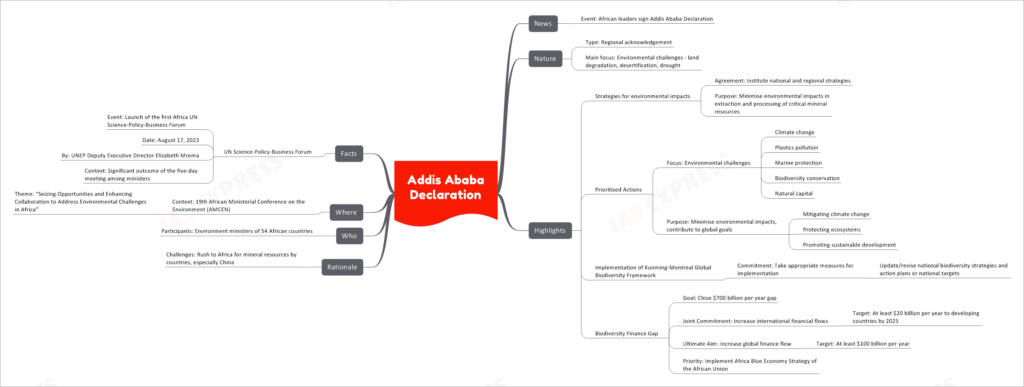Addis Ababa Declaration

In a monumental event, African leaders came together to sign the Addis Ababa Declaration, marking a pivotal regional acknowledgement of the pressing environmental challenges faced by the continent. This declaration underscores Africa’s commitment to address critical issues such as land degradation, desertification, and drought.
Nature and Focus
The Addis Ababa Declaration holds significance as a regional acknowledgement that emphasizes the shared responsibility of African nations in tackling environmental challenges that threaten the continent’s well-being.
Key Highlights
Strategies for Minimizing Environmental Impacts
- National and Regional Strategies: The declaration entails an agreement to institute comprehensive national and regional strategies aimed at minimizing environmental impacts during the extraction and processing of critical mineral resources.
Prioritized Actions for Environmental Sustainability
- Focus Areas: The declaration identifies key focus areas for action, including addressing climate change, tackling plastics pollution, marine protection, biodiversity conservation, and safeguarding natural capital.
- Purpose: These actions are aligned with the goal of minimizing environmental impacts while contributing to global objectives such as mitigating climate change, protecting ecosystems, and promoting sustainable development.
Implementation of the Kunming-Montreal Global Biodiversity Framework
- Commitment: The Addis Ababa Declaration commits African nations to take appropriate measures for the effective implementation of the Kunming-Montreal Global Biodiversity Framework.
- Strategy Updates: Nations will update or revise their national biodiversity strategies and action plans, as well as national targets, to align with the framework’s objectives.
Bridging the Biodiversity Finance Gap
- Closing the Gap: The declaration sets the ambitious goal of closing the biodiversity finance gap, estimated at $700 billion per year.
- Joint Commitment: African leaders commit to increasing international financial flows, targeting at least $20 billion per year to developing countries by 2025.
- Global Finance Flow: The ultimate aim is to increase global finance flow to a minimum of $100 billion per year.
- Priority: The declaration also underscores the importance of implementing the Africa Blue Economy Strategy of the African Union.
Rationale
- Challenges Addressed: The Addis Ababa Declaration is a response to the challenges posed by the rush for mineral resources in Africa, particularly by countries such as China.
Participants and Venue
- Participants: The declaration was signed by the environment ministers of 54 African countries, collectively demonstrating their commitment to environmental sustainability.
- Venue: The Addis Ababa Declaration was a significant outcome of the 19th African Ministerial Conference on the Environment (AMCEN), held under the theme “Seizing Opportunities and Enhancing Collaboration to Address Environmental Challenges in Africa.”
Facts and Outcomes
- UN Science-Policy-Business Forum: The launch of the first Africa UN Science-Policy-Business Forum was a significant outcome of the AMCEN meeting.
- Date: The forum was launched on August 17, 2023, under the leadership of UNEP Deputy Executive Director Elizabeth Mrema.
- Context: The forum’s establishment was a direct result of discussions and collaboration during the five-day AMCEN meeting.
If you like this post, please share your feedback in the comments section below so that we will upload more posts like this.

